Analysis of the Influence of Surrounding Rock State on Working Performance of Cutting Head in Metal Mining
Abstract
:1. Introduction
2. Materials and Methods
2.1. Boundary Conditions on Rock Mass
2.1.1. Boundary Condition in the Field
2.1.2. Boundary Conditions to Be Studied
2.2. Establishment of Hard Rock Cutting Model
2.2.1. Hard Rock Cutting Model
2.2.2. Material Constitutive Model
3. Results and Discussion
3.1. Stress Distribution on Rock Mass under Different Confining Pressure
3.2. Influence of the Confining Pressure on the Cutting Performance of Cutting Head
3.3. Influence of the Rotating Directions of Cutting Head on the Working Performance
3.3.1. Cutting Force of Shearer Drum
3.3.2. Stress in the Rock Mass
3.4. Influence of Free Surfaces on the Performance of Cutting Head
3.4.1. Free Surface at the Top Side of Rock Mass
- (1)
- For the deformation of rock mass in the y-direction, they can be divided into two parts based on sign: in the regions near the top of the rock mass, the displacement of the rock mass is positive; In other areas, the displacement of the rock mass is negative;
- (2)
- For the deformation of rock mass in the z-direction, the displacement of the rock near the free surface is the highest, while it gradually decreases as it moves away from the free surface at other positions;
- (3)
- The deformation of the rock mass near the rear side is negative, while deformation close to the front side is positive. The reasons for this phenomenon are as follows: (1) The rock mass close to the front side is more prone to deformation due to its proximity to the free surface, and the deformation follows the positive direction of the z-axis. (2) During the cutting process, the end plate of the cutting head would compress the rock mass close to the rear side, causing it to move along the opposite direction of the z-axis. However, due to the fully constrained rear side of the rock mass, the element displacements of the rock mass close to the rear side are smaller than the element displacements of the rock mass close to the front side.
3.4.2. Free Surface at the Rear Side of Rock Mass
- (1)
- There is no constraint applied on the rear side of the rock mass, and the rock mass is deformed along the z-direction due to the compression of the cutting forces of conical picks on the end plate of the cutting head during the cutting process;
- (2)
- The top and bottom sides of the rock mass are fully constrained, which means that even if some cutting forces from conical pick are applied on those regions, no displacement occurs. Therefore, the bulging deformation of the rock mass at the rear side of the rock mass would appear.
3.4.3. Free Surfaces at the Top and Rear Side of Rock Mass
3.4.4. Comparisons of Cutting Force in Conditions of Different Free Surfaces on Rock Mass
4. Conclusions
- (1)
- When the confining pressure on the rock mass is small, the mean cutting force of the cutting head is greater than that without confining pressure; The increase of confining pressure on the rock mass would be helpful to reduce the mean cutting force on cutting head and improve the cutting performance.
- (2)
- During the process of rock cutting, the rotating direction of the shearer drum have influence on the cutting performance of shearer drum. When the cutting head rotates in the clockwise direction, the cutting force is greater than that in the anti-clockwise cutting direction of cutting head.
- (3)
- The cutting force on the shearer drum could be influenced by the unconstrained surface on rock mass. The unconstrained surfaces on rock mass are helpful to reduce the cutting force on the shearer drum. Among the different boundary conditions, the best boundary condition to improve the cutting performance is to create a free surface on rock mass that is close to the end plate of the shearer drum.
Author Contributions
Funding
Institutional Review Board Statement
Informed Consent Statement
Data Availability Statement
Conflicts of Interest
References
- Munene, E.K.; Zhang, J.M.; Kasomo, R.M.; Mauti, D.; Mwangangi, J. A review of the influence of blast fragmentation on downstream processing of metal ores. Miner. Eng. 2022, 186, 107743. [Google Scholar]
- Eades, R.; Perry, K. Understanding the connection between blasting and highwall stability. Int. J. Min. Sci. Technol. 2019, 29, 99–103. [Google Scholar] [CrossRef]
- Abd Elwahab, A.; Topal, E.; Jang, H. Review of machine learning application in mine blasting. Arab. J. Geosci. 2023, 16, 133. [Google Scholar] [CrossRef]
- Roy, M.P.; Singh, P.K.; Sarim, M.; Shekhawat, L.S. Blast design and vibration control at an underground metal mine for the safety of surface structures. Int. J. Rock Mech. Min. 2016, 83, 107–115. [Google Scholar] [CrossRef]
- Wu, Y.; Mu, C.; Zong, Q.; Wu, J.; Zhou, H. Study on blasting vibration control of brick-concrete structure under subway tunnel. Appl. Sci. 2022, 12, 10960. [Google Scholar] [CrossRef]
- Ahmadi, S.; Moosazadeh, S.; Hajihassani, M.; Moomivand, H.; Rajaei, M.M. Reliability, availability and maintainability analysis of the conveyor system in mechanized tunneling. Measurement 2019, 145, 756–764. [Google Scholar] [CrossRef]
- Hoseinie, S.H.; Ataei, M.; Khalokakaie, R.; Ghodrati, B.; Kumar, U. Reliability analysis of drum shearer machine at mechanized longwall mines. J. Qual. Maint. Eng. 2012, 18, 98–119. [Google Scholar] [CrossRef]
- Ordin, A.A.; Okol’nishnikov, V.V.; Rudometov, S.V.; Metel’kov, A.A. Evaluation of drum shearer capacity in coal seam with variable geomechanical and geotechnical characteristics. J. Min. Sci. 2019, 55, 57–65. [Google Scholar] [CrossRef]
- Bredthauer, R.O. Strength characteristics of rock samples under hydrostatic pressure. J. Fluid Eng. 1957, 79, 695–706. [Google Scholar] [CrossRef]
- Lee, H.; Jeon, S. An experimental and numerical study of fracture coalescence in pre-cracked specimens under uniaxial compression. Int. J. Solids Struct. 2011, 48, 979–999. [Google Scholar] [CrossRef]
- Kumari, W.G.P.; Ranjith, P.G.; Perera, M.S.A.; Shao, S.; Chen, B.K.; Lashin, A.; Arifi, N.A.; Rathnaweera, T.D. Mechanical behaviour of Australian Strathbogie granite under in-situ stress and temperature conditions: An application to geothermal energy extraction. Geothermics 2017, 65, 44–59. [Google Scholar] [CrossRef]
- Shahverdiloo, M.R.; Zare, S. Experimental study of normalized confining pressure effect on Young’s modulus in different rock types. Arab. J. Geosci. 2023, 16, 55. [Google Scholar] [CrossRef]
- Li, Y.L.; Peng, J.M.; Zhang, P.Y.; Huang, C.Y. Hard rock fragmentation in percussion drilling considering confining pressure: Insights from an experimental study. Int. J. Rock Mech. Min. 2021, 148, 104961. [Google Scholar] [CrossRef]
- Qiao, S.; Wu, Y.; Zhu, Z.; Qing, L.; Huang, Z.; Ning, Q. Effects of confining pressure and cutting sequence on the cobalt-rich crust cutting mechanism by using conical picks in ocean environments. Ocean Eng. 2022, 263, 112348. [Google Scholar] [CrossRef]
- Qiao, S.; Wu, Y.; Zhu, Z.; Zhang, Z.; Lu, L. Numerical Investigation of Rock Cutting Modes with Conical Picks under Different Confining Pressures and Cutting Spaces. Arab. J. Sci. Eng. 2021, 47, 4559–4569. [Google Scholar] [CrossRef]
- Liu, W.; Deng, H.; Zhu, X.; Li, R.; He, C. Experimental study of the rock cutting mechanism with pdc cutter under confining pressure condition. Rock Mech. Rock Eng. 2023, 56, 7377–7396. [Google Scholar] [CrossRef]
- Tiryaki, B. In situ studies on service life and pick consumption characteristics of shearer drums. J. S. Afr. Inst. Min. Metall. 2004, 104, 107–121. [Google Scholar]
- Wan, L.; Jiang, K.; Gao, K.; Zeng, Q.; Zhang, X. Research of response difference on coal cutting load under different cutting parameters. Stroj. Vestn.-J. Mech. E 2019, 65, 420–429. [Google Scholar] [CrossRef]
- Xu, F.T.; Lu, J.J.; Zhou, H.; Xiao, J.C.; Gao, Y. Failure characteristics of rock sample during penetration tests with the assistance of different free surface combinations. Lithosphere 2022, 2021, 6216548. [Google Scholar] [CrossRef]
- Fenn, O. The use of water jets to assist free-rolling cutters in the excavation of hard rock. Tunn. Undergr. Space Technol. 1989, 4, 409–417. [Google Scholar] [CrossRef]
- Wang, S.F.; Li, X.B.; Du, K.; Wang, S. Experimental investigation of hard rock fragmentation using a conical pick on true triaxial test apparatus. Tunn. Undergr. Space Technol. 2018, 79, 210–223. [Google Scholar] [CrossRef]
- Zhu, G.-A.; Dou, L.-M.; Wang, C.-B.; Ding, Z.-W.; Feng, Z.-J.; Xue, F. Experimental study of rock burst in coal samples under overstress and true-triaxial unloading through passive velocity tomography. Saf. Sci. 2019, 117, 388–403. [Google Scholar] [CrossRef]


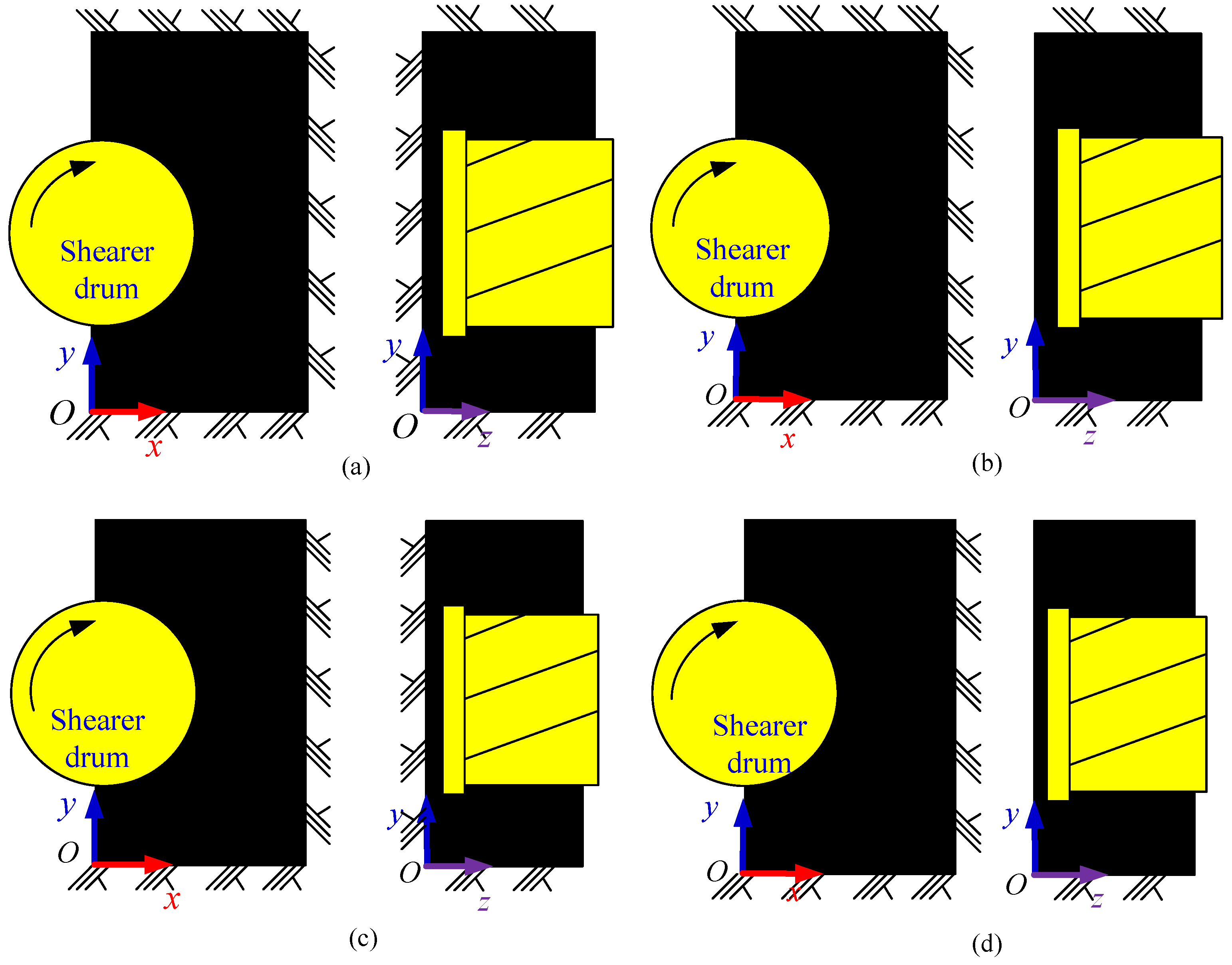

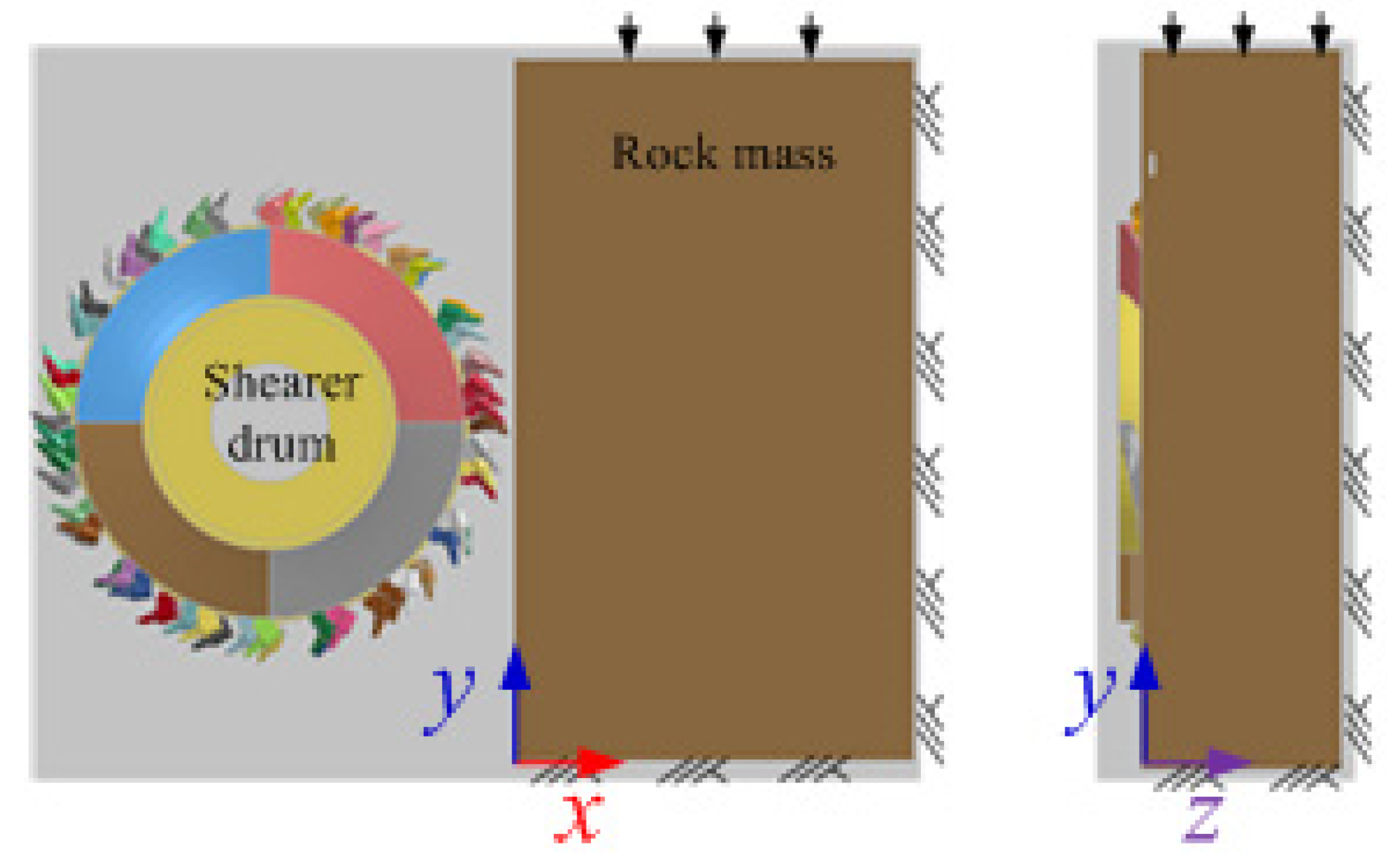
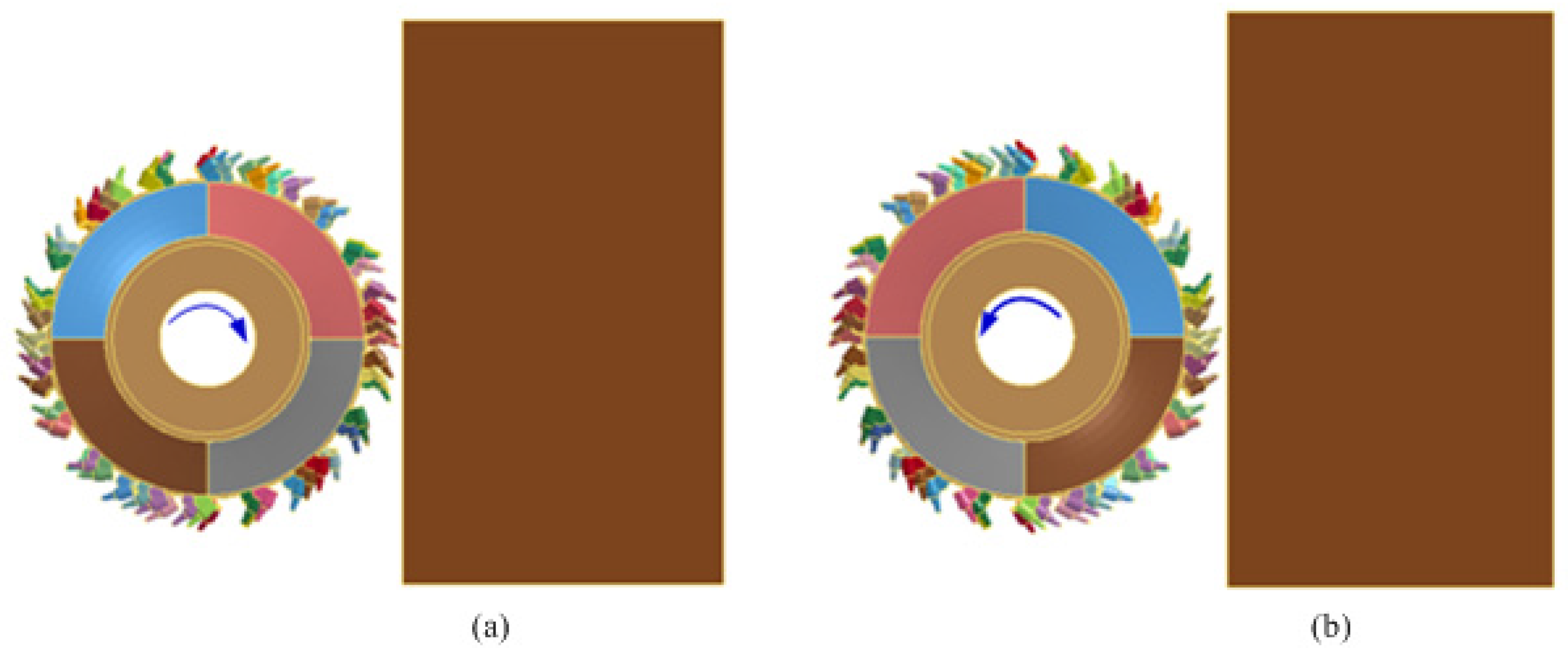
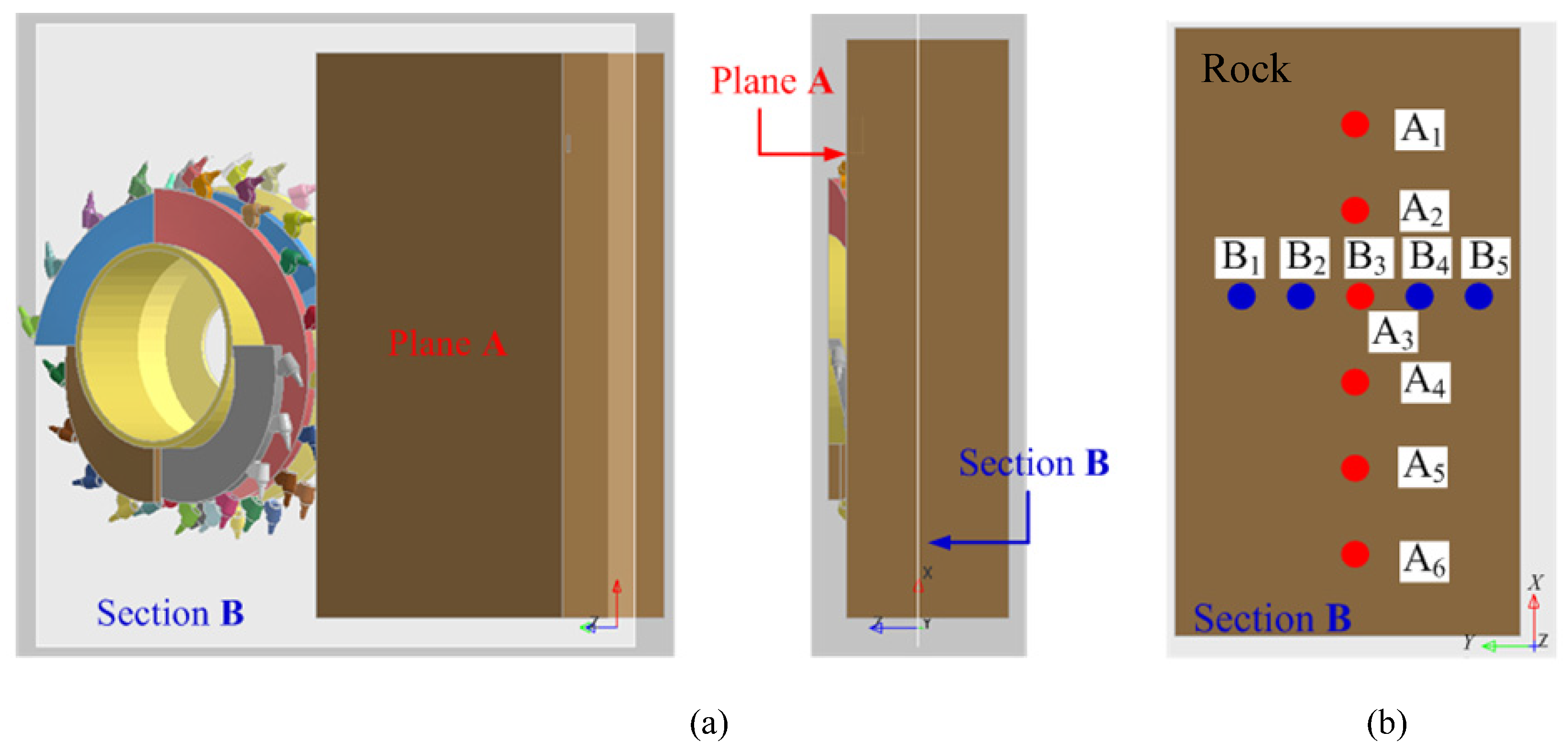








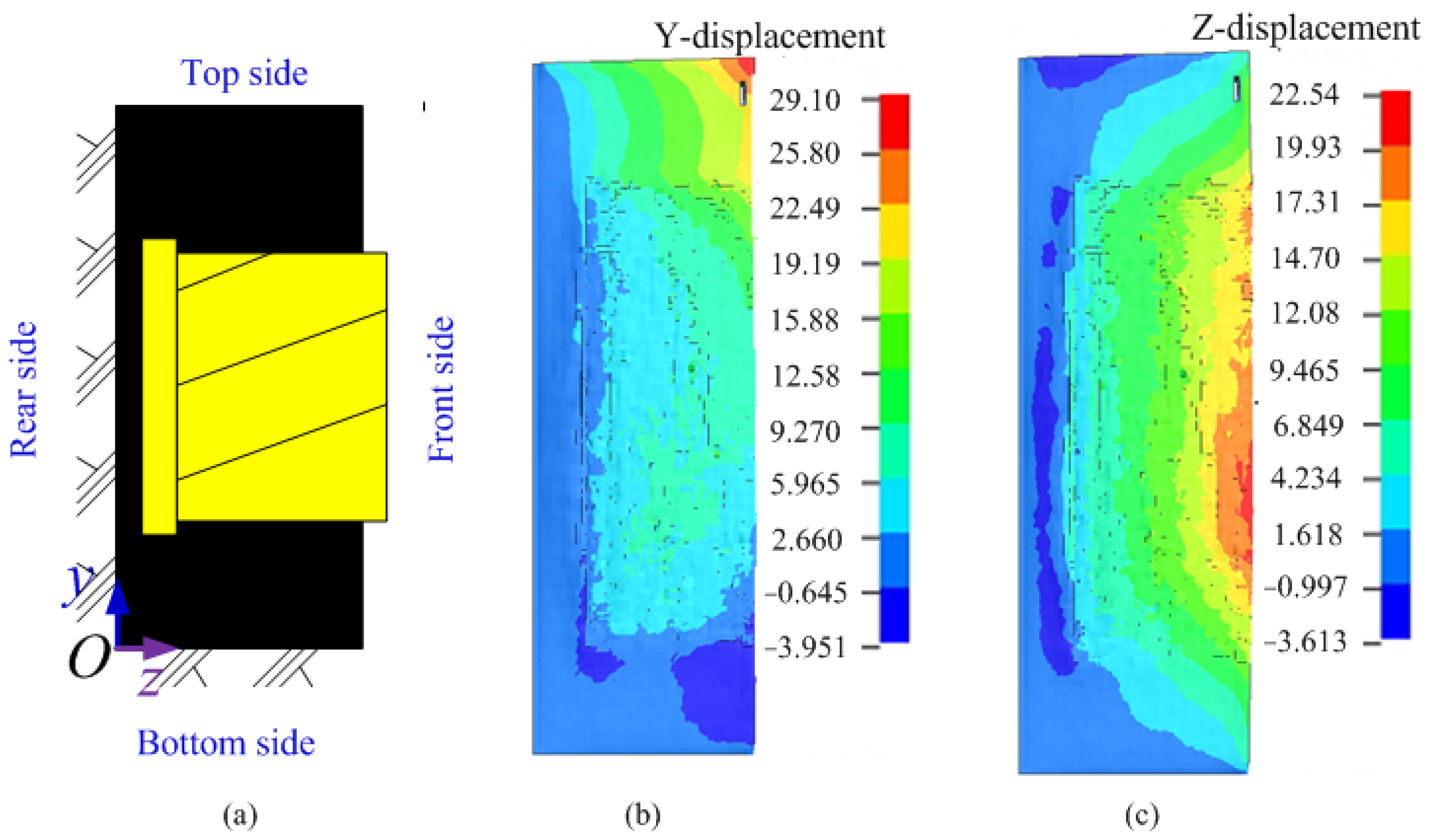
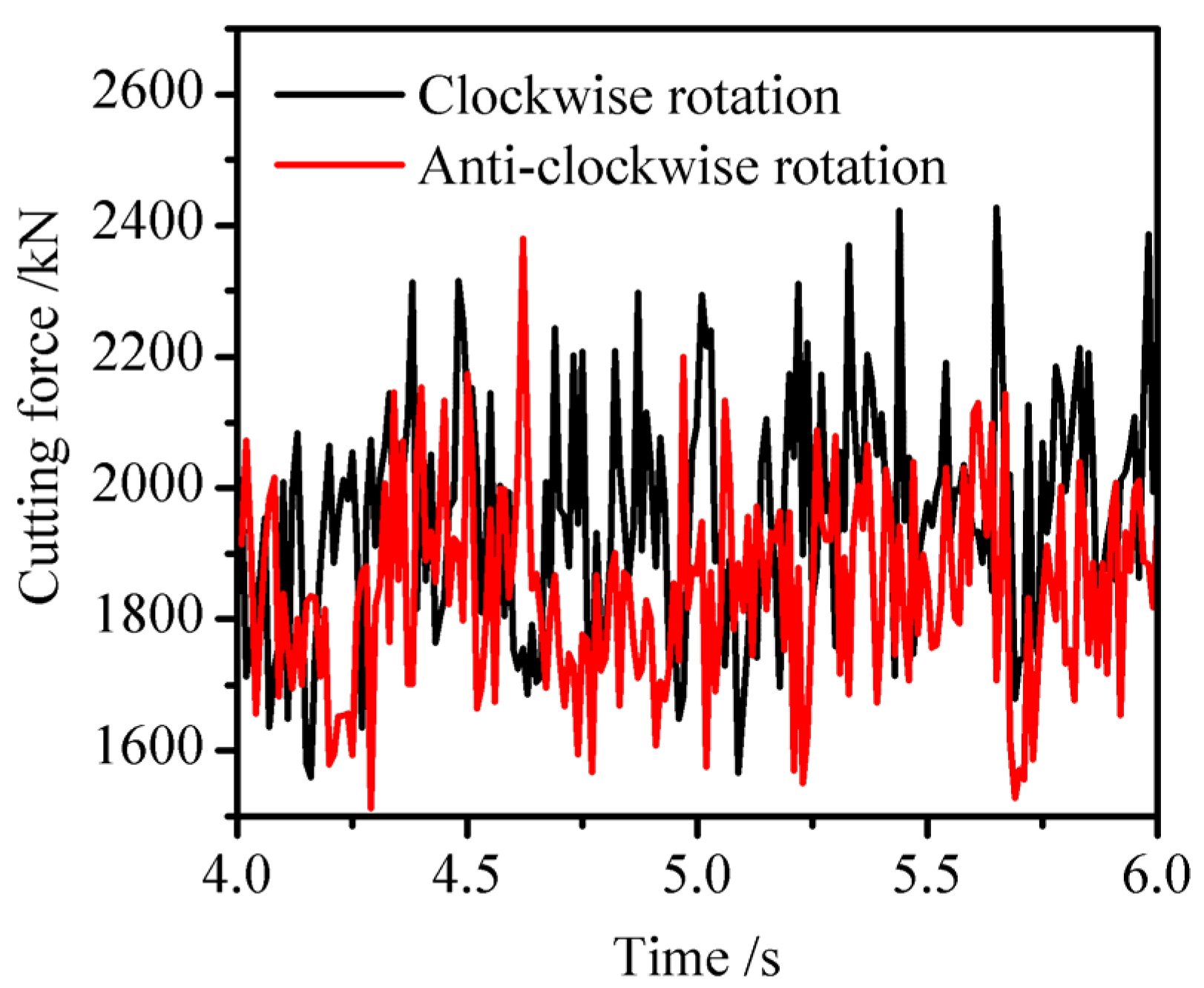
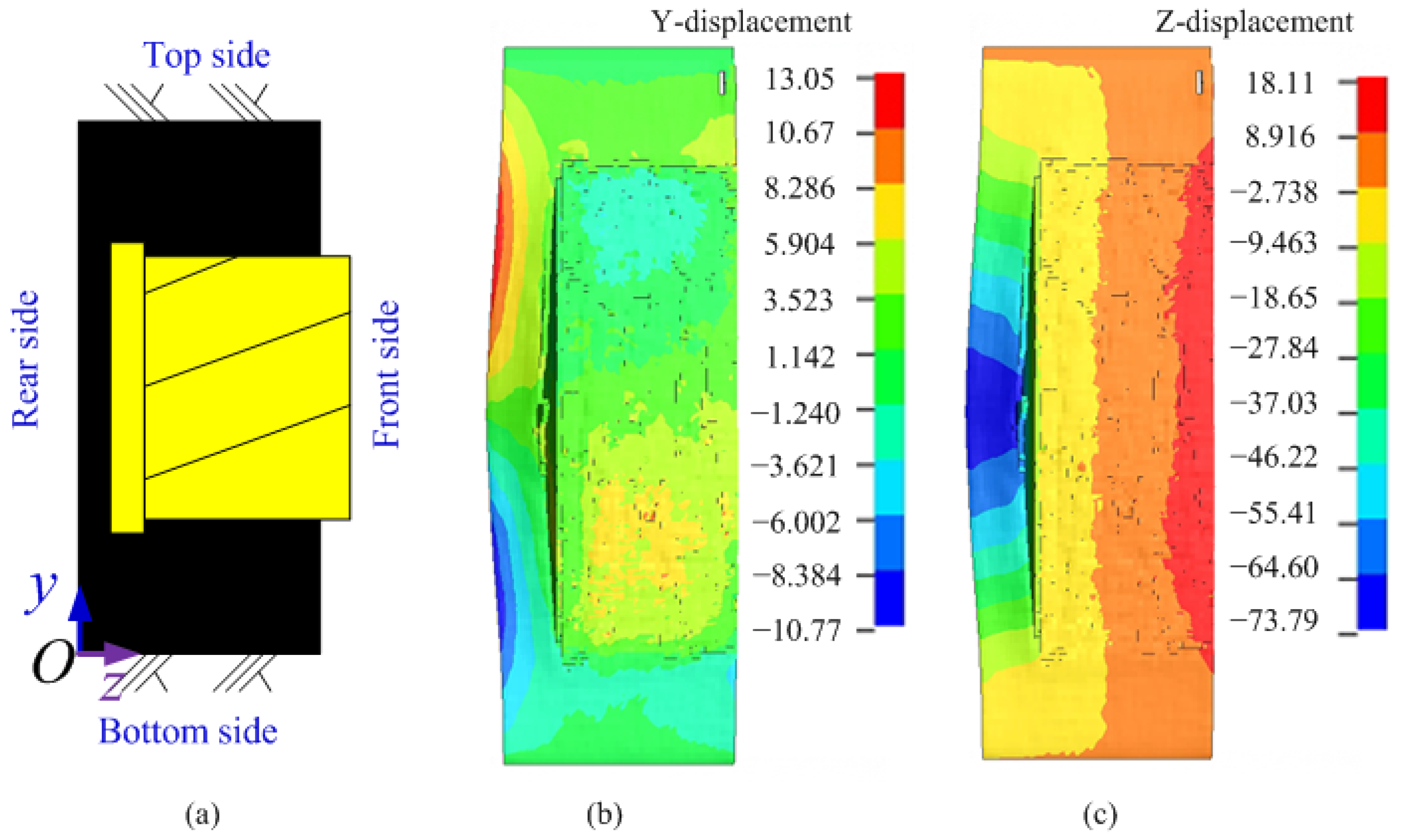



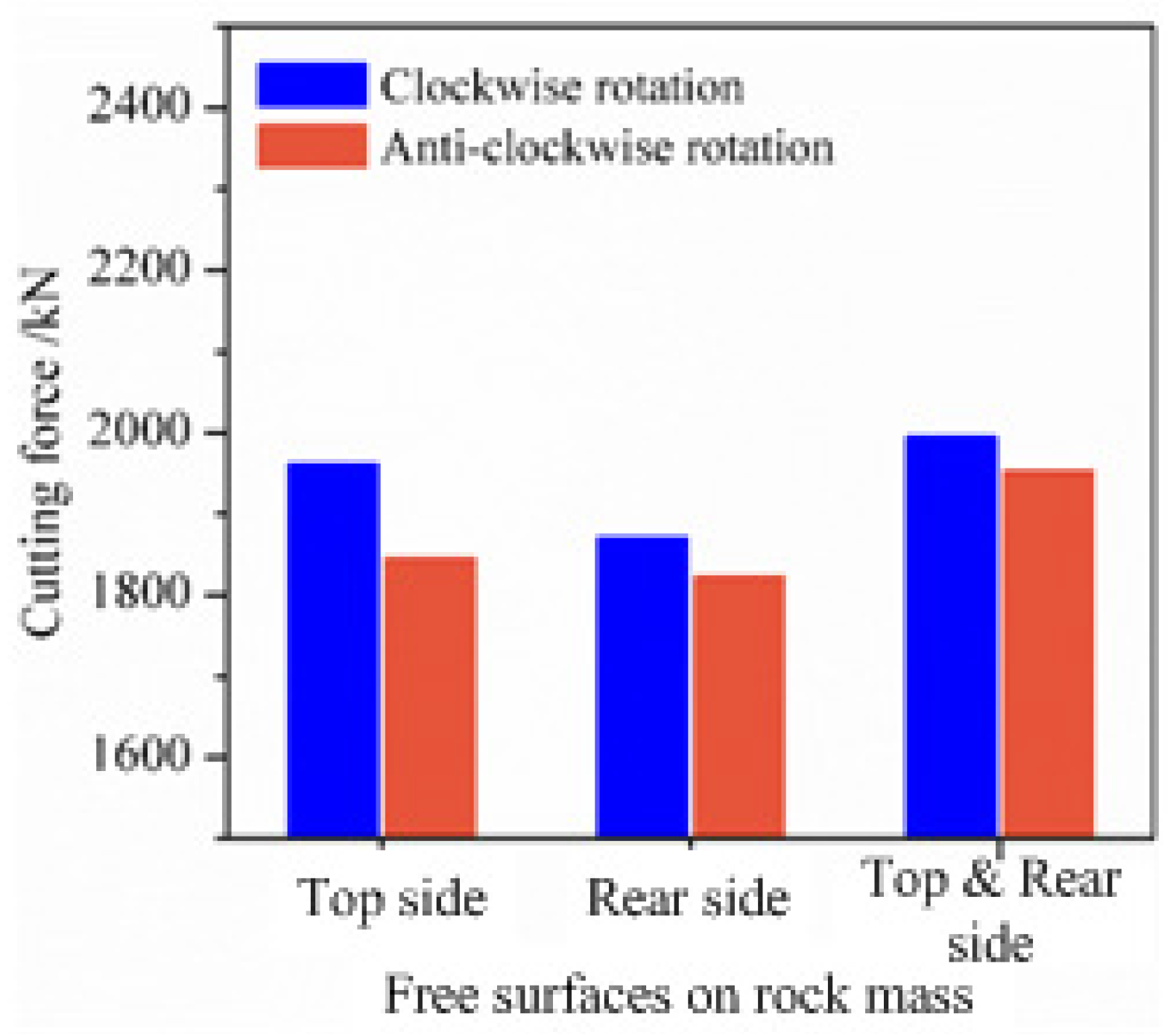
| Group | Plane A | Plane B | Plane C | Plane D | Plane E | Plane F |
|---|---|---|---|---|---|---|
| 1 | Constrain | Constrain | Constrain | Free | Constrain | Free |
| 2 | Constrain | Constrain | Constrain | Free | Free | Free |
| 3 | Free | Constrain | Constrain | Free | Constrain | Free |
| 4 | Free | Constrain | Constrain | Free | Free | Free |
| 5–11 | 0.5~10 MPa | Constrain | Constrain | Free | Constrain | Free |
| OA1/mm | OA2/mm | OA3/mm | OA4/mm | OA5/mm | OA6/mm |
|---|---|---|---|---|---|
| 470 | 940 | 1410 | 1880 | 2350 | 2820 |
| PB1/mm | PB2/mm | PB3/mm | PB4/mm | PB5/mm | |
| 300 | 600 | 900 | 1200 | 1500 |
Disclaimer/Publisher’s Note: The statements, opinions and data contained in all publications are solely those of the individual author(s) and contributor(s) and not of MDPI and/or the editor(s). MDPI and/or the editor(s) disclaim responsibility for any injury to people or property resulting from any ideas, methods, instructions or products referred to in the content. |
© 2023 by the authors. Licensee MDPI, Basel, Switzerland. This article is an open access article distributed under the terms and conditions of the Creative Commons Attribution (CC BY) license (https://creativecommons.org/licenses/by/4.0/).
Share and Cite
Xu, W.; Wan, L.; Gao, K.; Bu, Y.; Xu, M.; Ma, S.; Jiang, K. Analysis of the Influence of Surrounding Rock State on Working Performance of Cutting Head in Metal Mining. Appl. Sci. 2024, 14, 340. https://doi.org/10.3390/app14010340
Xu W, Wan L, Gao K, Bu Y, Xu M, Ma S, Jiang K. Analysis of the Influence of Surrounding Rock State on Working Performance of Cutting Head in Metal Mining. Applied Sciences. 2024; 14(1):340. https://doi.org/10.3390/app14010340
Chicago/Turabian StyleXu, Weipeng, Lirong Wan, Kuidong Gao, Yu Bu, Meng Xu, Shenghao Ma, and Kao Jiang. 2024. "Analysis of the Influence of Surrounding Rock State on Working Performance of Cutting Head in Metal Mining" Applied Sciences 14, no. 1: 340. https://doi.org/10.3390/app14010340





